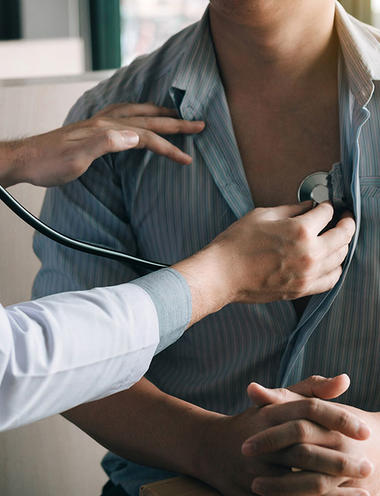We provide heart care including prevention, diagnostics, treatment, and rehabilitation. Services include:
Cardiovascular Diagnosis & Imaging
- Electrocardiogram (ECG or EKG), transesophogeal echocardiogram (TEE), and electrophysiology studies measure the heart's electrical activity and identify muscle damage that can cause heart disease.
- Nuclear medicine scans utilize a small dose of radioactive material to reveal the structure and blood flow within the heart during exercise and rest. Non-invasive imaging technologies such as magnetic resonance angiography (MRA), computed tomography angiography (CTA), X-ray and echocardiograms, which use ultrasound, provide images of the heart muscle, valves, veins, and arteries.
- Cardiac catheterization, or coronary angiogram, is an interventional cardiology procedure that provides real-time X-ray images (fluoroscopy) to show the heart’s pumping ability, the health of the valves and arteries, as well as measure blood pressure.
Heart Failure Care
- Heart failure occurs when the heart can no longer pump enough blood to meet the body's needs. Different from a heart attack, heart failure is a chronic, long-term condition that prevents the heart from functioning effectively. Doctors and nurses who specialize in heart failure provide a comprehensive management program that offers the latest treatment options, including medical management, risk-factor management, minimally invasive cardiac catheterization technique and surgery.
Interventional Cardiology
- In some cases, heart disease can be treated using minimally invasive interventional cardiology techniques that use a catheter (thin, flexible tube) inserted into the arteries. The catheter is guided to the heart to open blocked arteries and improve blood flow. These advanced techniques are performed on an outpatient basis and offer a non-surgical alternative to treat many heart conditions.
Heart Rhythm Disorders (Arrhythmia)
- Characterized by abnormal heart beat — too fast, too slow, or uneven. Doctors use tests such as an electrocardiogram (ECG or EKG), electrophysiology studies or a Holter monitor, which records heart activity over a period of time, to diagnose arrhythmias. Depending on the type and severity of the arrhythmia, there are a range of treatment options including lifestyle modification and medical management, cardioversion for fast arrhythmias, catheter ablation, implantable devices for slow heartbeat and surgical ablation to remove the tissue that is causing the arrhythmia.
Vascular Medicine
- We provide care for conditions such as aneurysm, atherosclerosis, Buerger's Disease, deep vein thrombosis, peripheral vascular disease, pulmonary embolism and varicose veins.
- We provide a full spectrum of care including advanced diagnostic technology, risk factor management and surgical interventions.
Heart Care for Women
Heart disease is the leading cause of death in women, and we are committed to raising awareness and encouraging preventive strategies to minimize risk among women. We have teamed up with The American Heart Association to increase awareness among women that heart disease is their leading killer, and a significant risk for the members of their families. Our “Go Red For Women” program is our commitment to educate women about their own heart health to promote longer, healthier lives.
Heart attack symptoms in women
Although the most common heart attack symptom for both men and women is chest pain or discomfort, women are more likely than men to experience some of the other common symptoms such as shortness of breath, nausea, and back or jaw pain. The most common symptoms of a heart attack include:
- Chest discomfort, which can feel like uncomfortable pressure, squeezing, fullness or pain in the center of your chest. The feeling can either last for more than a few minutes, or can go away and come back.
- Discomfort or pain in other areas of the upper body, such as in one or both arms, the back, neck, jaw or stomach.
- Shortness of breath with or without chest discomfort.
- Other signs may include breaking out in a cold sweat, nausea or vomiting, or lightheadedness.
Heart Care for Men
Men have a greater heart attack risk than women and they experience attacks earlier in life. The good news is that you can lower your risk of heart disease significantly by maintaining a healthy weight, eating a healthy diet, exercising, managing stress, avoiding smoking, and abstaining from or limiting alcohol consumption.
Heart attack symptoms in men
Symptoms can vary among men – some don’t experience chest pain at all. In some cases, symptoms are mild and can come on slowly, so heart attacks are not always easily recognizable. Being aware of all the symptoms can help save your life:
- Chest discomfort, which can feel like uncomfortable pressure, squeezing, fullness or pain in the center of your chest. The feeling can either last for more than a few minutes, or can go away and come back.
- Discomfort or pain in other areas of the upper body, such as in one or both arms, the back, neck, jaw or stomach.
- Shortness of breath with or without chest discomfort.
- Other signs may include breaking out in a cold sweat, nausea or vomiting, or lightheadedness.



